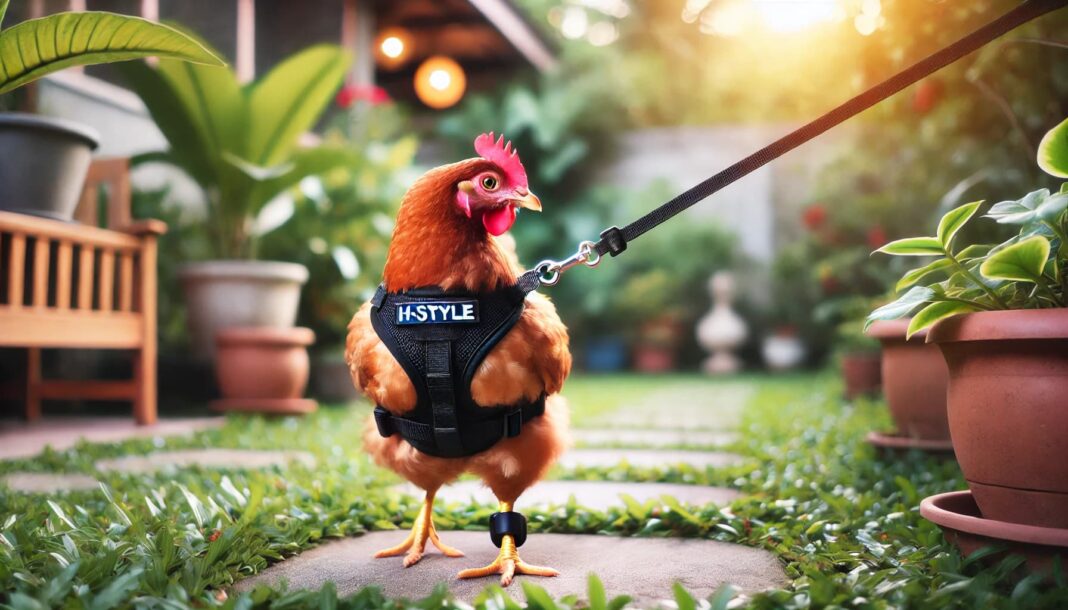If you’re a pet owner who loves to explore creative ways to keep your animals safe and stylish, you may have come across the idea of using an H-style cat harness on a chicken. While it may sound a bit quirky at first, this unconventional approach has been gaining popularity among poultry owners. In this blog post, we’ll delve into how an H-style cat harness can be used on chickens, the benefits, and some important things to keep in mind when trying this out for yourself.
What Is an H-Style Cat Harness?
Before we dive into the specifics of using an H-style harness on a chicken, it’s important to first understand what an H-style cat harness is. This type of harness is specifically designed for cats and gets its name from the “H” shape it forms across the animal’s chest and back. It typically consists of straps that go around the neck and chest, with a connecting strap across the back. The H-style design is popular because it evenly distributes pressure, making it comfortable and secure for the cat without putting too much strain on its delicate areas.
The harness is often adjustable, which means it can fit a variety of body sizes. This makes it suitable for both small and larger cats, and with some creativity, it can be adapted for use on other pets—like chickens!
Why Use an H-Style Harness on Chickens?
At first glance, you might think a harness for a cat would not suit a chicken, but there are a few reasons why poultry enthusiasts have started experimenting with this setup. Here are some of the benefits of using an H-style cat harness on chickens:
1. Control and Safety
Chickens, especially those that are free-range or spend a lot of time outdoors, can easily wander off and get into unsafe situations. An H-style harness allows you to safely control their movements without harming them. By attaching a leash to the harness, you can take your chicken for walks or supervise their outdoor activities in a safe and controlled manner.
2. Comfort and Fit
H-style cat harnesses are designed to be comfortable for pets to wear for long periods. The adjustable straps ensure that the harness fits snugly around the chicken’s body, without causing discomfort. Since chickens are quite small, it’s important to ensure that the harness isn’t too tight or loose, so they can move freely.
3. Training and Bonding
Using a harness on your chicken can also be a great way to train them to be more social and comfortable with human interaction. A harness gives you more control over the chicken’s movements, making it easier to handle them when necessary. It’s a fun way to strengthen your bond with your feathered friend.
4. Exploring New Spaces
If you want to take your chicken to different places, like a backyard garden or even inside the house, an H-style harness can help you keep track of their movements. Chickens are naturally curious, and a harness allows them to explore new environments while keeping them safe and secure.
How to Properly Fit and Use an H-Style Harness on a Chicken
Now that we know the benefits of using an H-style harness on a chicken, let’s walk through how to properly fit and use one.
1. Choose the Right Size
One of the most important things to remember when using an H-style harness on a chicken is to choose the right size. Chickens come in various breeds, and each breed can vary in size. You’ll want to ensure that the harness is snug enough to stay on securely but loose enough to allow your chicken to move comfortably. Measure the chest girth of your chicken before purchasing a harness to get an accurate size.
2. Adjust the Straps
Once you have the harness, place it over the chicken’s head and gently adjust the straps. The chest strap should be placed across the chicken’s breastbone, and the back strap should fit along the back. Ensure that the harness doesn’t pinch or restrict movement. The harness should be comfortable but snug enough that your chicken cannot slip out of it.
3. Introduce the Harness Gradually
Chickens can be sensitive to new experiences, so it’s essential to introduce the harness gradually. Start by letting your chicken get used to the harness being around them. Place it near their resting area so they can inspect it, and over time, gently place it on them. Some chickens might resist at first, but with patience and practice, they will likely get used to it.
4. Supervise Outdoor Time
Once your chicken is comfortable wearing the harness, you can take them outside to explore. Always supervise them closely, especially if they are in a new environment. If your chicken is unaccustomed to the outdoors, start in a quiet, enclosed area like a backyard or chicken coop before letting them roam in open spaces.
Potential Drawbacks to Consider
While using an H-style cat harness on a chicken can be a fun and safe way to interact with your pet, there are a few potential drawbacks to consider:
1. Chickens’ Natural Movements
Chickens are not used to being tethered in the same way as cats or dogs, and they may struggle to adjust to the sensation of being restrained. Be mindful of your chicken’s behavior and avoid leaving the harness on for too long if it seems to cause stress.
2. Potential for Injury
If the harness is too tight or not fitted properly, it could cause discomfort or injury to the chicken. Always check for any signs of discomfort, such as panting, difficulty moving, or redness under the straps.
Conclusion
Using an H-style cat harness on a chicken might seem like an unconventional idea, but it can offer many benefits for both you and your feathered friend. From providing safety and control to enhancing your bond and allowing your chicken to explore new environments, a harness can be a great tool for responsible pet owners. Just remember to choose the right size, adjust the harness properly, and always supervise your chicken when they’re wearing it. With a little patience and care, you’ll both enjoy the experience!



